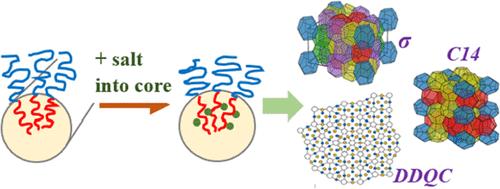当前位置:
X-MOL 学术
›
Macromolecules
›
论文详情
Our official English website, www.x-mol.net, welcomes your
feedback! (Note: you will need to create a separate account there.)
Accessing the Frank–Kasper Phase of Block Copolymer via Selective Incorporation of Metal Salt
Macromolecules ( IF 5.1 ) Pub Date : 2024-11-08 , DOI: 10.1021/acs.macromol.4c02302
Yu-Jung Hsiao, Zi-En Huang, Aditya Sahare, Meng-Zhe Chen, Yu-Hsuan Lin, Hsin-Lung Chen
Macromolecules ( IF 5.1 ) Pub Date : 2024-11-08 , DOI: 10.1021/acs.macromol.4c02302
Yu-Jung Hsiao, Zi-En Huang, Aditya Sahare, Meng-Zhe Chen, Yu-Hsuan Lin, Hsin-Lung Chen

|
The formation of Frank–Kasper (FK) phase in block copolymers (BCPs) has been achieved through delicate design of the chemical structure and architecture of the BCP, as well as by blending with homopolymer or another BCP component. Here, we report a new approach of generating FK phase via selective incorporation of a metal salt into a BCP. Specifically, the selective incorporation of lithium perchlorate (LiClO4) into the poly(ethylene oxide) (PEO) domain of a cylinder-forming poly(ethylene oxide)-block-poly(1,2-butadiene) (PEO-b-PB) was found to create a window for the spherical phase at the higher temperature, in which the micelles packed preferentially into FK σ phase or dodecagonal quasicrystal (DDQC). The addition of a bivalent salt, magnesium perchlorate (Mg(ClO4)2), expanded the spherical phase window further, where the micelles still preferred packing in the σ and DDQC phases. Nevertheless, with sufficiently high Mg(ClO4)2 concentration, the micelles were found to organize into the Laves C14 phase instead of recovering the DDQC and σ phases during cooling from the disordered micelle phase. We proposed that the preferential solubilization of salt in the PEO core increased the effective interaction parameter of the BCP, leading to greater stretching of the constituent blocks due to the formation of a larger core. The increased tendency to reduce the conformational free energy penalty of the coronal blocks facilitated the access of spherical phase at higher core volume fractions, thereby promoting the micelle organization into FK phases. The present study highlights the effectiveness of metal salts in promoting the complex packing of BCP micelles, providing a simple alternative for modulating the structure of spherical phase.
中文翻译:

通过选择性掺入金属盐获得嵌段共聚物的 Frank-Kasper 固定相
嵌段共聚物 (BCP) 中 Frank-Kasper (FK) 相的形成是通过对 BCP 的化学结构和结构进行精细设计,以及与均聚物或其他 BCP 组分共混来实现的。在这里,我们报道了一种通过将金属盐选择性掺入 BCP 来产生 FK 相的新方法。具体来说,发现高氯酸锂 (LiClO4) 选择性掺入圆柱形聚(环氧乙烷)-嵌段-聚(1,2-丁二烯)(PEO-b-PB) 的聚(环氧乙烷)(PEO) 结构域,在较高温度下为球形相创造了一个窗口,其中胶束优先堆积到 FK σ相或十二边形准晶 (DDQC) 中。添加二价盐高氯酸镁 (Mg(ClO4)2) 进一步扩大了球形相窗口,其中胶束仍然更喜欢在 σ 和 DDQC 相中堆积。然而,在足够高的 Mg(ClO4)2 浓度下,发现胶束在从无序胶束相冷却过程中组织成 Laves C14 期,而不是恢复 DDQC 和 σ 期。我们提出盐在 PEO 核心中的优先溶解增加了 BCP 的有效相互作用参数,由于形成更大的核心,导致组成块的更大拉伸。减少冠状块的构象自由能损失的趋势增加,促进了较高核心体积分数的球相进入,从而促进胶束组织进入 FK 期。 本研究强调了金属盐在促进 BCP 胶束复杂堆积方面的有效性,为调节球相的结构提供了一种简单的替代方案。
更新日期:2024-11-08
中文翻译:

通过选择性掺入金属盐获得嵌段共聚物的 Frank-Kasper 固定相
嵌段共聚物 (BCP) 中 Frank-Kasper (FK) 相的形成是通过对 BCP 的化学结构和结构进行精细设计,以及与均聚物或其他 BCP 组分共混来实现的。在这里,我们报道了一种通过将金属盐选择性掺入 BCP 来产生 FK 相的新方法。具体来说,发现高氯酸锂 (LiClO4) 选择性掺入圆柱形聚(环氧乙烷)-嵌段-聚(1,2-丁二烯)(PEO-b-PB) 的聚(环氧乙烷)(PEO) 结构域,在较高温度下为球形相创造了一个窗口,其中胶束优先堆积到 FK σ相或十二边形准晶 (DDQC) 中。添加二价盐高氯酸镁 (Mg(ClO4)2) 进一步扩大了球形相窗口,其中胶束仍然更喜欢在 σ 和 DDQC 相中堆积。然而,在足够高的 Mg(ClO4)2 浓度下,发现胶束在从无序胶束相冷却过程中组织成 Laves C14 期,而不是恢复 DDQC 和 σ 期。我们提出盐在 PEO 核心中的优先溶解增加了 BCP 的有效相互作用参数,由于形成更大的核心,导致组成块的更大拉伸。减少冠状块的构象自由能损失的趋势增加,促进了较高核心体积分数的球相进入,从而促进胶束组织进入 FK 期。 本研究强调了金属盐在促进 BCP 胶束复杂堆积方面的有效性,为调节球相的结构提供了一种简单的替代方案。

































 京公网安备 11010802027423号
京公网安备 11010802027423号